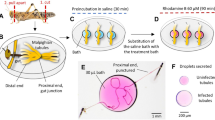Summary
-
1.
The urine of blood-fed mosquitos was collected and analyzed for elemental composition and osmolality.
-
2.
Peak rates of urine flow averaged 4.9 droplets/min at 6 min following the beginning of the bloodmeal; peak flow urine contained, in mM, Na 178, K 4, and Cl 132, and the urine was approximately isosmotic to hemolymph.
-
3.
As urine flow rates fell, the [Na] of the urine decreased and the [K] increased. Urine osmolality declined, measuring less than 100 mOsm/kg in some samples, as compared to 354 mOsm/kg measured in pre-bloodmeal hemolymph.
-
4.
When urine flow rates had fallen to less than 10% of peak flow rates, urine again became approximately isosmotic to hemolymph, still containing Na and K as the principal cations.
-
5.
Approximately 40% each of the water, Na and Cl contained in the plasma fraction of the bloodmeal was excreted during the 1–2h period following the bloodmeal. This excretion represents only 20–30% of the total loads ingested in the bloodmeal.
-
6.
The data are consistent with dynamic changes in the functioning of both the Malpighian tubules and hindgut during the post-bloodmeal diuresis.
Similar content being viewed by others
References
Aston RJ (1975) The role of adenosine 3′:5′-cyclic monophosphate in relation to the diuretic hormone ofRhodnius prolixus. J Insect Physiol 21:1873–1877
Bonventre JV, Blouch K, Lechene C (1981) Liquid droplets and isolated cells. In: Mazat MA (ed) X-ray microscope in biology, University Park Press, Baltimore, pp 307–366
Boorman JPT (1960) Observations on the feeding habits of the mosquitoAedes (Stegomyia) aegypti (Linnaeus): the loss of fluid after a blood-meal and the amount of blood taken during feeding. Ann Trop Med Parasitol 54:8–14
Christophers SR (1960)Aedes aegypti (L.) the yellow fever mosquito. Cambridge University Press, London, pp 468, 489
Clements AN (1963) The physiology of mosquitoes. Pergamon Press, New York, pp 159–161
Florkin M, Jeuniaux C (1974) Hemolymph: composition. In: Rockstein M (ed) The physiology of insecta, 2nd edn, vol 5. Academic Press, New York London, pp 255–307
Gee JD (1975) Diuresis in the tsetse flyGlossina austeni. J Exp Biol 63:381–390
Gee JD (1977) The hormonal control of excretion. In: Gupta BL, Moreton RB, Oschman JL, Wall BJ (eds) Transport of ions and water in animals. Academic Press, London New York San Francisco, pp 265–281
Hanaoka K, Hagedorn HH (1980) Brain hormone control of ecdysone secretion by the ovary in a mosquito. In: Hoffman JA (ed) Progress in ecdysone research. Elsevier, Amsterdam, pp 467–480
Howard LM (1962) Studies on mechanism of infection of the mosquito midgut byPlasmodium gallinaceum. Am J Hyg 75:287–300
Mack SR, Vanderberg JP (1978) Hemolymph ofAnopheles stephensi from noninfected andPlasmodium berghei-infected mosquitoes. I. Collection procedure and physical characteristics. J Parasitol 64:918–923
Maddrell SHP, Phillips JE (1978) Induction of sulfate transport and hormonal control of fluid secretion by Malpighian tubules of larvae of the mosquitoAedes taeniorhynchus. J Exp Biol 72:181–202
Nijhout HF, Carrow GM (1978) Diuresis after a bloodmeal in femaleAnopheles freeborni. J Insect Physiol 24:293–298
Phillips JE (1981) Comparative physiology of insect renal function. Am J Physiol 241:R241-R257
Pilitt DR, Jones JC (1972) A qualitative method for estimating the degree of engorgement ofAedes aegypti adults. J Med Entomol 9:334–337
Roinel N (1975) Electron microprobe quantitative analysis of lyophilized 10−10 l volume samples. J Microsc (Paris) 22:261–268
Shapiro JP, Hagedorn HH (1982) Juvenile hormone and the development of ovarian responsiveness in the mosquito,Aedes aegypti. Gen Comp Endocrinol 46:176–183
Stobbart RH (1977) The control of diuresis following a bloodmeal in females of the yellow fever mosquitoAedes aegypti (L.). J Exp Biol 69:53–85
Wigglesworth VB (1931) The physiology of excretion in a bloodsucking insect,Rhodnius prolixus (Hemiptera, Reduviidae) I. Composition of the urine. J Exp Biol 8:411–427
Williams JC, Beyenbach KW (1983) Differential effects of secretagogues on Na and K secretion in the Malpighian tubules ofAedes aegypti (L.). J Comp Physiol 149:511–517
Winogradskaja ON (1936) Osmotischer Druck der Hämolymphe beiAnopheles maculipennis messeae Fall. Z Parasitenkd 8:697–713
Author information
Authors and Affiliations
Rights and permissions
About this article
Cite this article
Williams, J.C., Hagedorn, H.H. & Beyenbach, K.W. Dynamic changes in flow rate and composition of urine during the post-bloodmeal diuresis inAedes aegypti (L.). J Comp Physiol B 153, 257–265 (1983). https://doi.org/10.1007/BF00689629
Accepted:
Issue Date:
DOI: https://doi.org/10.1007/BF00689629



